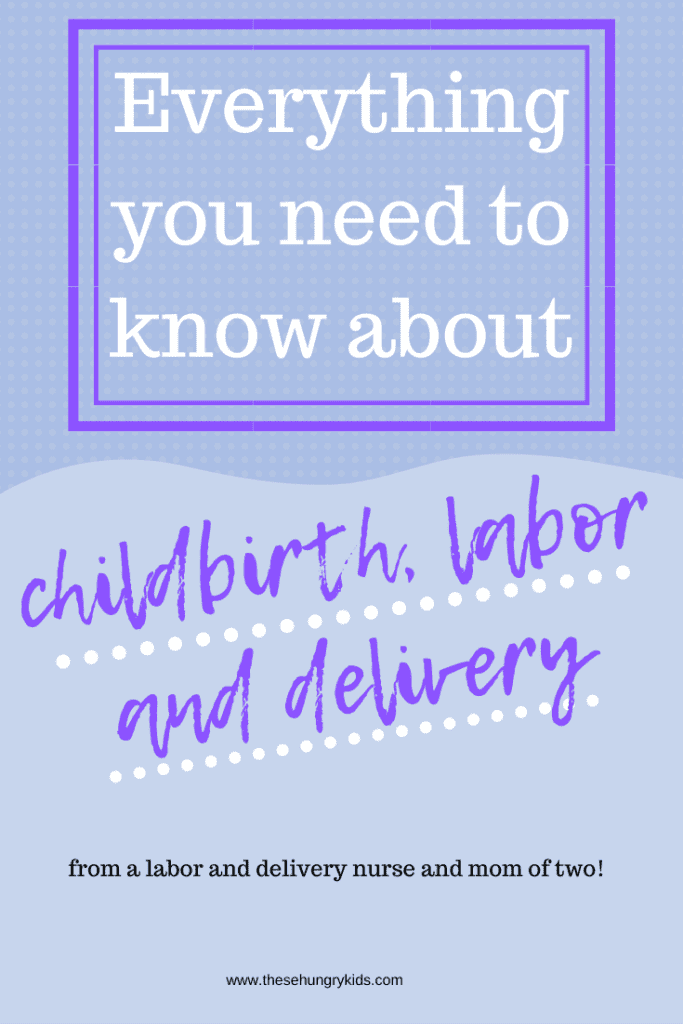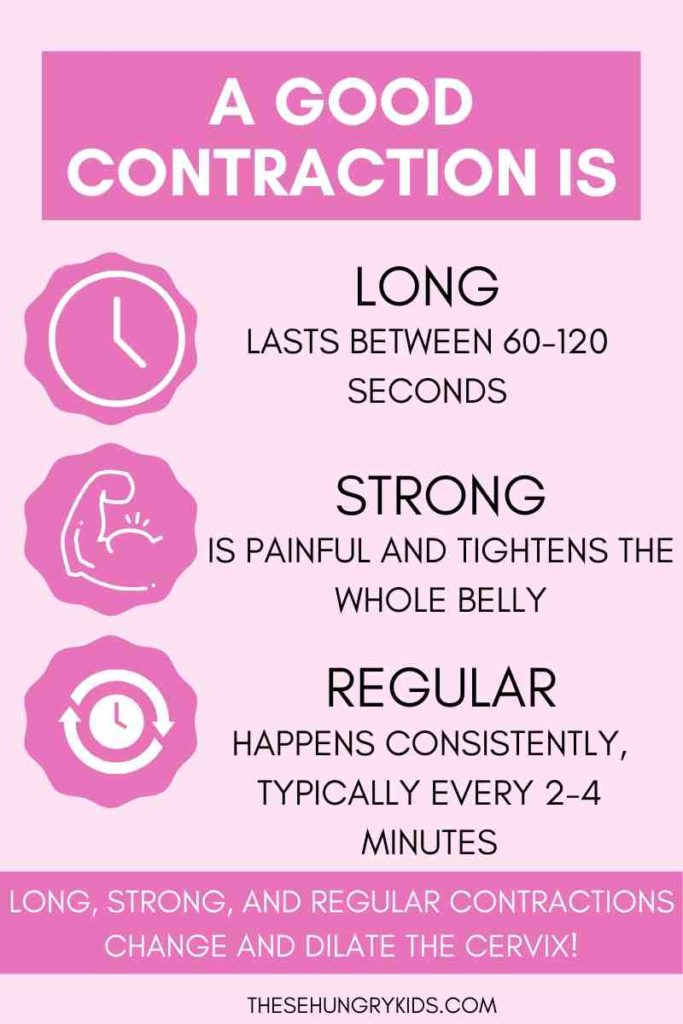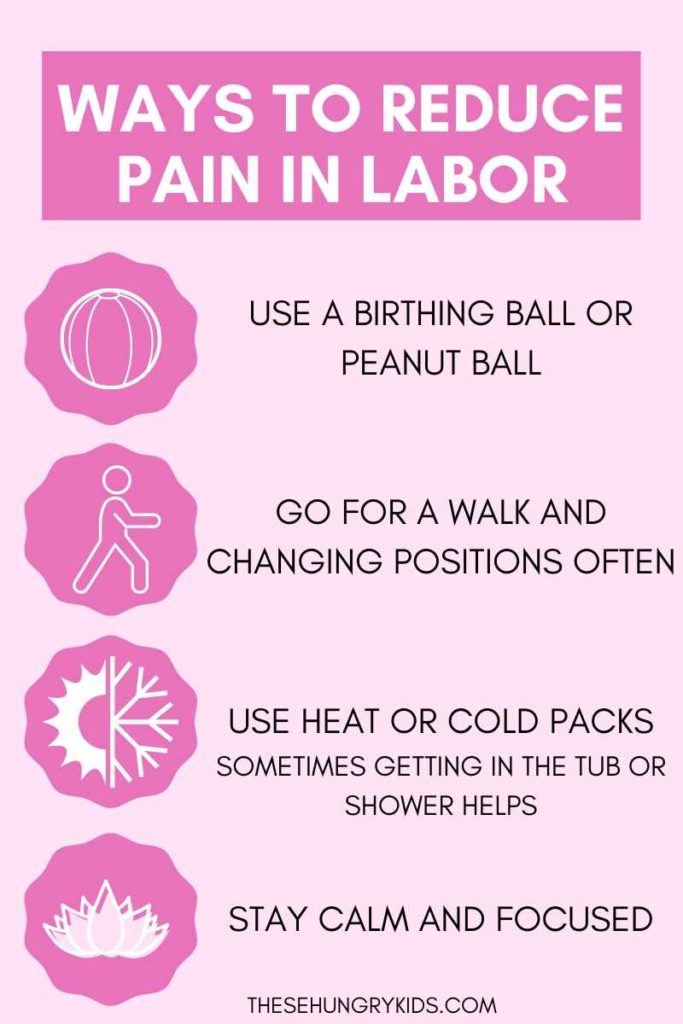Make labor and birth easier by learning exactly what to expect. You can rock your labor like the queen that you are with these labor tips from a mom and labor nurse!
Labor…so scary…so exciting…and so many unknowns!
I remember feeling excited for labor with my first pregnancy! I thought, “I can handle it! At the end I get to meet my BABY!! How bad could it be?!”
When they started my induction with Pitocin, I actually said, “Pitocin?! Ha-ha-ha! I laugh in the face of Pitocin!” (If you got my Lion King reference, we’re going to be friends.)
But man, I knew NOTHING about labor.
It was after this first birth, and the terrible traumatic drama that ensued, that I decided I would change my field of nursing to become a labor and delivery nurse. Birth should be empowering, exciting and wonderful. But mine was full of the opposite…I felt out of control, manipulated, and abused.
I decided to become a labor and delivery nurse because:
- No one should feel the way I did during labor. It’s a story for another day, but it was horrible.
- I wanted to learn everything I could about labor and delivery so I could teach my patients and families how to rock their births, but also so I could ensure my future births wouldn’t go the same way (mission accomplished! I’ve since had two natural and empowering deliveries.)
- It’s magical. Watching a baby be born is absolutely thrilling. I love watching how families change and grow with the addition of a little one. And (most) of the time it is truly a gift to watch how these families look at their little ones with awe and adoration.
Fortunately my second and third births was amazing. I trusted my providers, my providers trusted me, and everyone worked together to bring my sweet girls into the world. I am so grateful for that experience!
In this post you’ll learn expect in labor, and how to make it through each phase of labor. Through education is power!

My mission is to prepare and inform, not advise. There is no place for shame or guilt in labor – you are entitled to give birth however you see fit. Pain meds, no pain meds, vaginal or c-section, you rock it, mama!!The information in this post is purely for entertainment and is not meant to replace the advice of a medical professional. I always adhere to HIPPAA policies, any similarities to yours or anyone else’s story is purely coincidental. Please see my disclosure policy for more information. This post contains affiliate links, meaning I may earn a small commission at no additional cost to you if a purchase is made using the links. This helps fund this site, and keeps These Hungry Kids up and running. Thank you!
Early labor
I don’t want to minimize the discomfort and pain of early labor, because it definitely hurts.But until you experience active labor, it’s hard to understand the difference. Early labor is typically the longest, and by definition ends around 3-6cm.
Early labor contractions feel:
- Irregular – they may be every 5 minutes for a while, and then every 30 minutes, then every 2 minutes, then stop altogether (it can be very frustrating!)
- Short – lasting between 30-60 seconds
- Uncomfortable – they may feel like period cramps, a back ache, or you may just notice intermittent tightening of your belly, similar to Braxton Hicks
- Can come and go for hours to days
If early labor contractions continue to get stronger, more painful, and closer together, you are likely progressing to active labor.
Early labor is a great time to relax at home, if possible. Many people feel they need to rush to the hospital, and that may be necessary if you are pre-term, live far away or if your provider has instructed you to come to the hospital right away. It is important to know yours and your baby’s health.
What to do for pain relief in early labor
- Take a shower
- Sit in a warm bath
- Try listening to music, lighting candles
- Have your partner give you a back or foot rub
- Stay hydrated, eat small, light meals and snacks (keep in mind many women vomit during active labor – don’t eat anything that would be ruined forever if it came back up)
- Try some Spinning Babies techniques to help ensure your body is ready for labor — side lying release is my favorite place to start, but the Spinning Babies website is FANTASTIC and I reference it often.
Enjoy your early labor! Take it as a time to rest, prepare, and get psyched for active labor!

Active labor
This is when sh** gets real, baby!
These contractions hurt. This is the time where most people should head to the hospital.
Active labor contractions tend to be 2-3 minutes apart, lasting 60-120 seconds and are more painful than early labor contractions. They are regular, and change the cervix from 3-7cm.
Most people are in active labor for several hours, approximately 3-8 hours, though there are people who deliver much quicker than that!
Active labor contractions feel:
- Intense and painful – eventually you will not be able to walk or talk through them
- At regular intervals – timing from the start of one contraction to the start of the next, they should be between 2-4 minutes apart
- May cause nausea – women in active labor do not usually have an appetite. The pain may be intense enough to cause vomiting.
- May cause your water to break

If you can, try to rest between contractions. Focus on relaxing your face, shoulders, hips, and legs in between contractions. Your support person should encourage you to drink water or suck on ice to stay hydrated.
What to do when your water breaks:
- Take note of time and color of fluid – normal fluid is clear and without strong odor. If the fluid is brown, has brown/black flecks in it, or is bloody, you need to call your provider head to the hospital right away
- Amniotic fluid should not have a strong odor – if the odor is foul, call your provider and head to the hospital
- There should never be umbilical cord visible – if the umbilical cord is visible, get onto your hands and knees and call for an ambulance. This is an emergency.
What to do for pain relief in active labor
- Change position frequently
- Ideally, every few contractions
- The first contraction after each position change tends to be extra intense
- Move intuitively – if you need to squat, then squat. If you need to sway, then sway! Let your body guide you!
- Gather your support team – before labor, communicate your wants and anticipated needs with your partner.
- Get your epidural if you want one
- If you get an epidural, don’t stop moving! Ask your nurse to help you change positions in bed. Roll side to side, sit up, lay back, etc! I LOVE using peanut balls on my patients after an epidural.
- Take advantage of the rest. Sleep between your position changes.
- For more information on epidurals, read here.
- Use a birthing ball or peanut ball – these tools help to keep your muscles, joints and ligaments loose.
- Get in the tub or shower – if possible, get into a tub or shower. This is a great pain relief method!
- For a complete list of pain relief options in labor, read here.

I am a big lover of birthing balls during pregnancy and labor. I sat on one throughout the end of each of my pregnancies, and labored for a long time on one with each of my babies!
Birthing balls are not just for sitting on. You can also use them by kneeling and leaning over, as a footrest while sitting on a sofa or rocking chair, and to lean against sideways for support. I always get them out for my patients and very rarely does someone not use it.
Birth Balls help labor by:
- Opening up the pelvis to make room for baby
- Taking the pressure off your butt and back during contractions
- Allows you to squat and sit with support, and you can move side to side during contractions
- Gives you something to focus on during contractions – think about moving your hips in a circle, side to side, or a figure-8 during the painful contractions
- Keeps you from feeling stuck in bed
- Can offer support for your chest and belly if you choose to kneel
I really like this particular birth ball. It’s a high quality, thick ball that comes with some great tools.
Each ball comes with its own easy-to-use pump so the ball can be as firm or soft as you like it. It also comes with a guide full of exercises for each trimester of pregnancy. The birth balls are intended for use from the first trimester through after the baby is born! Their balls are created specifically with pregnant women in mind. The balls are much thicker and safer than a regular exercise ball. There are few things worse than the thought of a ball breaking under a pregnant woman!
I could not have gotten through the last few weeks of my pregnancies without a birth ball and a bathtub. It made a tremendous difference to my third trimester comfort.
Transition phase
MAN, I HATE THIS PHASE.
The transition phase is the most intense phase of labor. Your hormones surge, the contractions feel non-stop, and anxiety peaks.
Transition begins around 7cm and ends at 10cm when you are ready to start pushing.

Transition labor is marked by:
- Very intense contractions. They will be strong and close together.
- Anxiety and panic. This is often when many moms start saying things like “I can’t do this” or “I need help” and begin to panic.
- Shaking is normal. The surge of hormones that comes with the transition phase of labor often causes shaking. It’s totally normal! It often subsides after delivery.
- Crying, screaming, cursing, or just being totally distant. Some moms are completely in the “zone” while others scream, cry and curse.
- Nausea and vomiting.
- Feeling extremely hot or extremely cold.
Having a strong support person is crucial during transition. Moms need a lot of reassurance during this phase. Your support person should be chanting the following words:
- You are amazing.
- You are doing great.
- This is normal.
- You are doing exactly what you need to be doing.
- You are strong.
- Each contraction is one step closer to meeting the baby.
- Rest your body between contractions.
- You are safe.
- Here’s a sip of water.
- You were made for this.
- You are incredible.
Actually, just print those out and repeat them over and over again until the baby is born. Everyone will thank you. She will probably not have many words to say to you, may curse you out, may tell you to shut up…but it is what she needs to hear. Don’t take anything personally at this stage. The mind is not clear.
The transition is the quickest, but most intense part of labor. I don’t even need to check a cervix to know if a patient is in transition, because her whole demeanor changes.
Pain during transition
During transition, it’s common to feel overwhelmed by pain. I remember thinking “there is NO way anyone else has ever experienced this level of pain.” The contractions come back to back and seem like they won’t quit.
But eventually, they do! That’s the most important thing to remember! It’s important to continue changing positions. Many moms feel it’s most comfortable to labor on a toilet, squat, be on hands and knees, or lean against the bed, birthing ball, or their partner.
Just when you think you can’t do it any longer, labor is almost over.
The best advice I ever got in any phase of labor (but especially transition) is “DON’T FIGHT THE CONTRACTION!” Let it come, and let it go! It’s going to happen either way, so it’s best to breathe through it, let your body relax, and let your cervix dilate. It will be over soon!
And now, for the grand finale…PUSHING!
You did it! You rocked your labor like a boss and it’s time to get this little babe out!

Here is my pushing advice:
- “Don’t be a pretty pusher” – this one comes from my mom (holla to you Kimbo!)
- Push with a purpose! You won’t look good doing it. It’s impossible.
- It’s OK to poop, and it actually feels like you will. And you know what, you might poop during labor!
- Push into the pressure – it will be very intense, but the best thing you can do is try to make the pressure even stronger. There’s one way out, and that way is to make the pressure feel unbearable. I promise you – once the baby is born it’s an indescribable wave of relief, and all the pain is gone!
- Listen to coaching from your provider – if they tell you to give little pushes or stop pushing for a second, try to listen even if it’s hard. It’s important to allow the skin to stretch and the baby to rotate to prevent tearing
- You don’t have to push on your back! Try different pushing positions to see what’s comfortable and effective. You can try a birthing bar, squatting, hands and knees, and side lying. See what feels best!
- Listen to your body and push with contractions. There’s actually a reflex called the fetal-ejection reflex where your body will just start pushing, whether you want it to or not. It’s a very difficult feeling to explain, but there is really no way to stop it! If you feel your body pushing the baby out, follow its cues and push with all your might!
- Don’t get discouraged – it’s a two steps forward, one step back kind of process
- Eventually the baby rocks under the pubic bone and stays there, but it can take awhile to push a baby out!
- It can be normal to push for a few hours for your first baby
- “WHAT!? OMG?! REALLY?! NO. WAY.” Yes. Yes it can. But sometimes pushing feels better than laboring. It’s difficult to explain!
When the baby is out, you’ll feel a huge sense of relief. Congratulations, you did it!! This gorgeous little person is yours forever, love and cherish them.
Delivering the placenta
You’ll have to deliver the placenta, which typically happens within 10-20 minutes after the baby is born.
Your provider may ask you to give a little push while they tug gently on the cord, but don’t worry! It’s nothing like giving birth to your baby since the placenta is soft and squishy (no bones, yay!).
After the baby is born, if all is well, I encourage you to stay skin to skin with them for at least an hour. Tell your family and friends they can come in a few hours. Take the first few moments to soak up your little one. It’s a great time to start breastfeeding if you are planning to do so, and it’s a time to rest and recuperate.
You can check out this post to learn more about what to expect during the first few days with baby.
I hope you learned a lot from this post. I love my job as a labor nurse, I love my babies, and I am so passionate about this subject. Please leave me a comment below if this article taught you something, or if there’s a new subject you’d like me to touch on!



Amazing!!!! This should be printed and handed out by on/gyn offices !!!
Thank you! <3